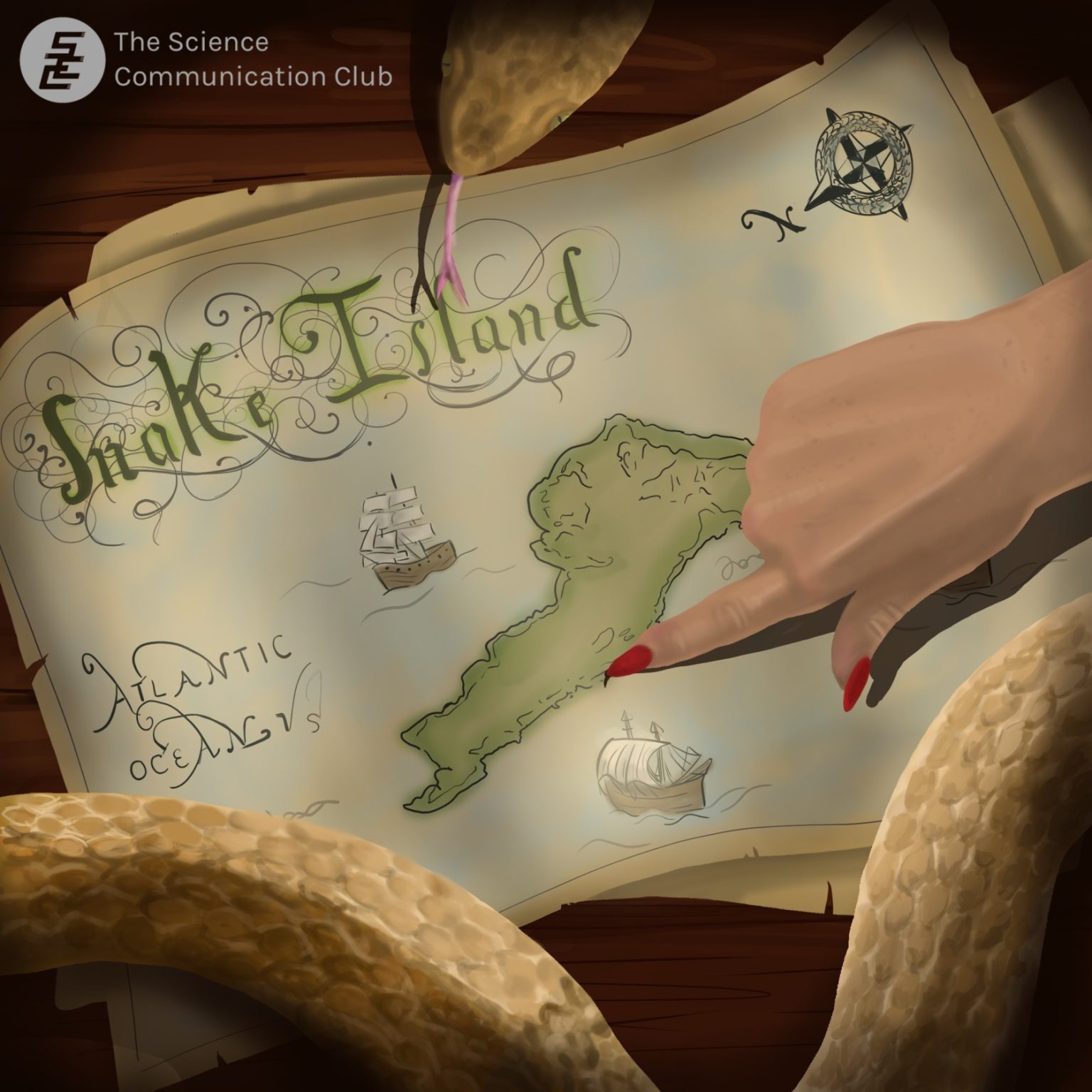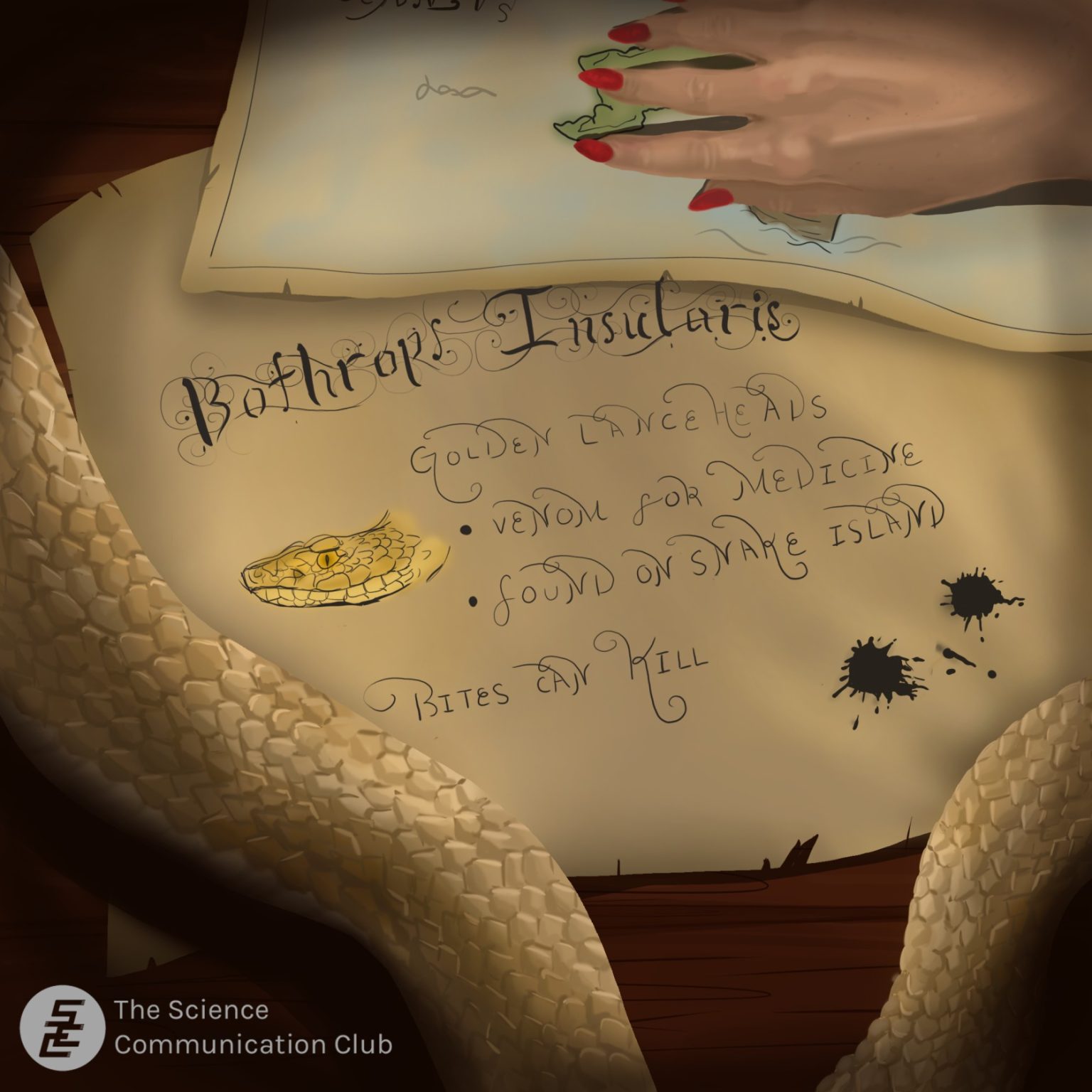
Written by Selin Eda Sagnak
Illustrated by Sania Bahman
As we scroll social media, we come across interesting “facts”. Some are true, some are not, and some of them exploit the fact that we don’t know much about a topic or a place. Today, we’ll be introduced to an island that is quite mysterious: Ilha da Queimada Grande, in other words Snake Island.
This forbidden island lies off the coast of São Paulo, Brazil.1 It is known to be an inhabitable island as it is full of the world’s most venomous snakes.1 The hosts of this island are the golden lanceheads: Bothrops insularis, which are known for their ability to kill their pray in one bite.1 Despite being extremely dangerous, these snakes could be the education ambassadors of their genus, and a future hope for medicine, making them of high interest for scientists.1 Even though the bite of the golden lancehead can result in health complications such as “kidney failure, necrosis of muscular tissue, brain hemorrhaging and intestinal bleeding”, it is also seen to improve “heart disease, circulation and blood clots”.1 So, it is safe to say that this venom is an area of high research.
I know you might be wondering how these snakes got to this island to begin with. Well, the golden lanceheads actually share the same ancestor with the snakes in mainland Brazil.1 There have been theories suggesting human intervention in the past, as it was thought pirates brought them to the island, however it is now known to be false.1 Then, how is it possible that these snake species share an ancestor? Snakes can’t cross oceans, can they?
Well, in this case they didn’t. 11,000 years ago, a geographical change has caused the island we see now to be isolated from the mainland, trapping the ancestor of the golden lancehead in itself.1 Hence, the ancestor had a chance to evolve into a new species endemic in the newly formed island.1

Let’s talk a little bit about the golden lancehead’s biology. The reproduction of golden lanceheads have been studied by Marques et al.2 It is interesting that reproduction is quite a stable system across both golden lanceheads in the snake island and other snakes in the mainland.2 However, this shouldn’t lead you to the assumption that all these snakes reproduce equally. The fertility of the snakes change depending on how much nutrient is available, the approximate body size, and many other factors.2 They found that the golden lanceheads had smaller body sizes, hence less fertility, but also reproductive cycles that shifted towards the winter of the southern hemisphere with longer durations. However, the ratio observed between female-to-male body size proportions showed a similar trend of larger females.2 The difference in size between the two species has been hypothesized to be related to the golden lancehead’s need to hunt for birds, requiring them to be more athletic in trees, which a smaller size allows for.2
Unfortunately, the golden lanceheads are among the critically endangered snakes in Brazil. Causes behind this are habitat destruction and the illegal trade of the snakes.1,2 A study by Salles-Oliveira et al., has proposed some strategies to overcome the endangerment through genetic causes, like initiated outbreeding. This was based on the usual traits found in endangered species, such as inbreeding and lack of diversity in their experiments.3 Other ongoing conservation studies aim to protect this mysterious species which still holds a lot of hidden answers.
Overall, the snake island is both an amazing source of information for ecology and medicine, yet it is also one of the most dangerous places to visit. It is fascinating how much information is still yet to be uncovered about this island and its main host: the golden lancehead. Even if it calls to your curiosity, make sure to search your bucket list destinations in case of another “snake island”.
- Geiling N. This Terrifying Brazilian Island Has the Highest Concentration of Venomous Snakes Anywhere in the World. Smithsonian Magazine. 2014 Jun 25 [accessed 2023 Nov 23]. https://www.smithsonianmag.com/science-nature/snake-infested-island-deadliest-place-brazil-180951782/#:~:text=The%20snakes%20that%20ended%20up,seasonally%E2%80%8B%20during%20long%20flights.
- Marques OAV, Kasperoviczus K, Almeida-Santos SM. Reproductive Ecology of the Threatened Pitviper Bothrops insularis from Queimada Grande Island, Southeast Brazil. Journal of Herpetology. 2013;47(3):393–399. doi:10.1670/11-267
- Salles‐Oliveira I, Machado T, Banci KRDS, Almeida‐Santos SM, Silva MJDJ. Genetic variability, management, and conservation implications of the critically endangered Brazilian pitviper Bothrops insularis. Ecology and Evolution. 2020;10(23):12870–12882. doi:10.1002/ece3.6838